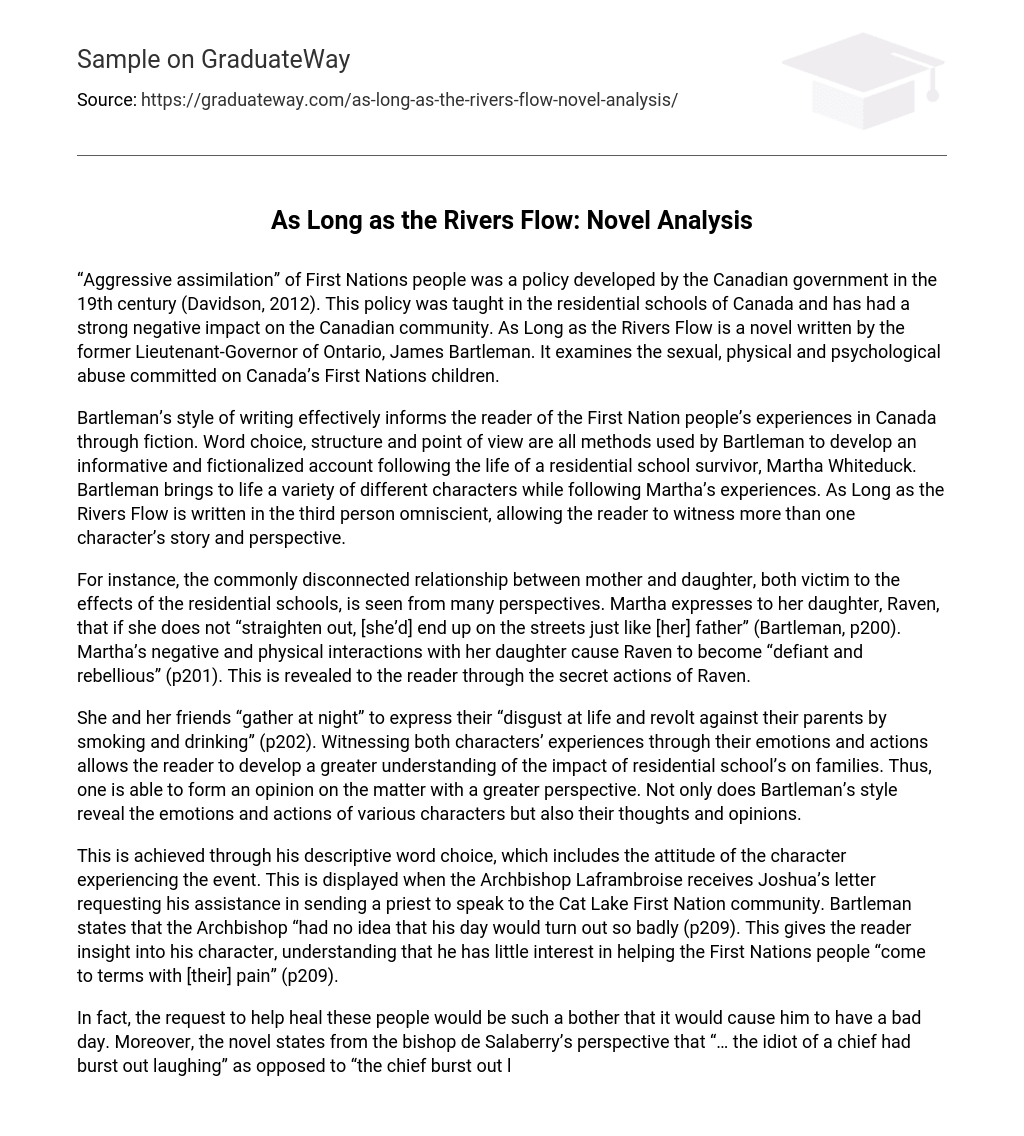“Aggressive assimilation” of First Nations people was a policy developed by the Canadian government in the 19th century (Davidson, 2012). This policy was taught in the residential schools of Canada and has had a strong negative impact on the Canadian community. As Long as the Rivers Flow is a novel written by the former Lieutenant-Governor of Ontario, James Bartleman. It examines the sexual, physical and psychological abuse committed on Canada’s First Nations children.
Bartleman’s style of writing effectively informs the reader of the First Nation people’s experiences in Canada through fiction. Word choice, structure and point of view are all methods used by Bartleman to develop an informative and fictionalized account following the life of a residential school survivor, Martha Whiteduck. Bartleman brings to life a variety of different characters while following Martha’s experiences. As Long as the Rivers Flow is written in the third person omniscient, allowing the reader to witness more than one character’s story and perspective.
For instance, the commonly disconnected relationship between mother and daughter, both victim to the effects of the residential schools, is seen from many perspectives. Martha expresses to her daughter, Raven, that if she does not “straighten out, [she’d] end up on the streets just like [her] father” (Bartleman, p200). Martha’s negative and physical interactions with her daughter cause Raven to become “defiant and rebellious” (p201). This is revealed to the reader through the secret actions of Raven.
She and her friends “gather at night” to express their “disgust at life and revolt against their parents by smoking and drinking” (p202). Witnessing both characters’ experiences through their emotions and actions allows the reader to develop a greater understanding of the impact of residential school’s on families. Thus, one is able to form an opinion on the matter with a greater perspective. Not only does Bartleman’s style reveal the emotions and actions of various characters but also their thoughts and opinions.
This is achieved through his descriptive word choice, which includes the attitude of the character experiencing the event. This is displayed when the Archbishop Laframbroise receives Joshua’s letter requesting his assistance in sending a priest to speak to the Cat Lake First Nation community. Bartleman states that the Archbishop “had no idea that his day would turn out so badly (p209). This gives the reader insight into his character, understanding that he has little interest in helping the First Nations people “come to terms with [their] pain” (p209).
In fact, the request to help heal these people would be such a bother that it would cause him to have a bad day. Moreover, the novel states from the bishop de Salaberry’s perspective that “… the idiot of a chief had burst out laughing” as opposed to “the chief burst out laughing” when referencing the events of the healing circle at Cat Lake First Nation (p225). This gives the reader insight into the bishop’s thoughts towards the situation, that he does not respect the chief of the Cat Lake First Nation.
As a result, the reader gains awareness to the potential factors that contributed to the long lasting harm of the First Nations people. Those in power with the ability to amend the issue of abuse in the residential schools would often try to ignore such complaints due to their neglect and lack of sympathy for the Natives. The consequences of the residential school system on the community have many long-term affects. Bartleman demonstrates these affects by structuring the novel into three parts, each part exploring the consequences at different points in Martha’s life.
The first part takes place during “The Early Years” from Martha’s birth until the age of 35. This includes her years spent in a residential school as well as her experiences at home in the Cat Lake First Nation. Bartleman exposes the truth that many residential school children do not feel as though they belong at home, unable to speak their native tongue or practice cultural traditions, nor do they feel they belong away from their Native community. Alcohol became a common outlet to ease the pain brought by memories of abuse at school for Martha and many other former students.
Part Two brings attention to the difficulties that come with Natives attempting to live in the city of Toronto during discriminative times. Not only does Part Two evaluate Martha’s life in Toronto but also her son, Spider. As an adopted child with fetal alcohol syndrome, Spider’s story and perspective illustrates the mental and physical problems experienced by the children of former residential school students. Part Three informs the reader of the lasting problems of the residential schools on the children that were brought up by residential school survivors in a First Nations ommunity. The novel deals with the issue of suicide with the First Nation children and the reluctant help of the church to resolve ongoing issues despite the closing of the residential schools. Bartleman section’s Marta’s life into three parts as a method of discussing the events that take place over many years. This allows the reader to have a clearer understanding of the school’s impact on not just on an individual, but the Canadian community. Overall, James Bartleman successfully addresses the issues of marginalization and assimilation of First Nations people in Canada.
Through Bartleman’s stylistic choices, As Long as the Rivers Flow narrates the fictional story of a Native raised in the residential school system. Perspectives of those discriminated against as well as those who were prejudice towards Native’s are brought to light, allowing the reader to form a less bias opinion on the historical events. Very little of the powerful and disturbing truth about Canadian and Native history is left out. This leaves the reader to contemplate his or her own situation in Canada in comparison to Martha’s situation.





